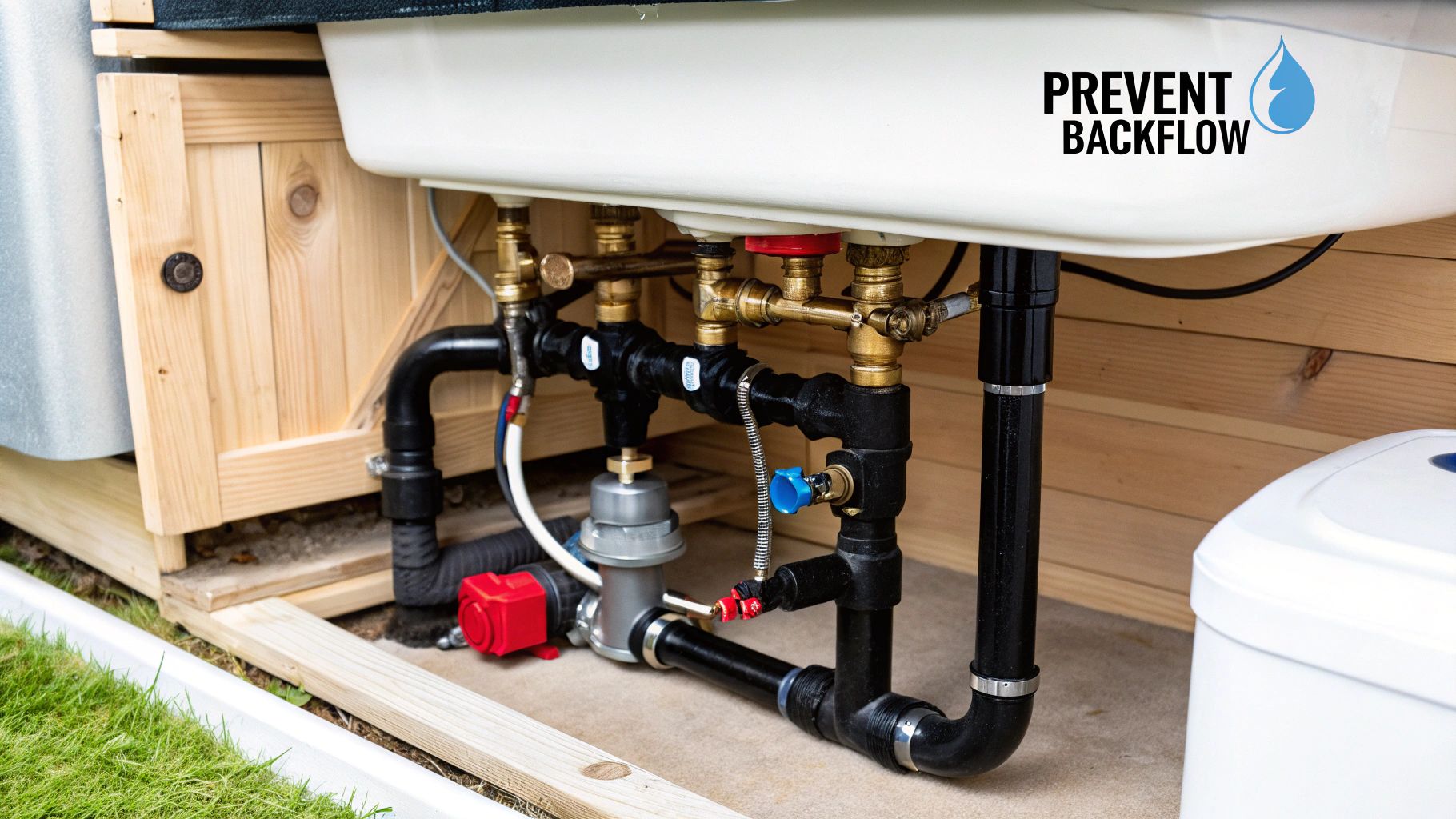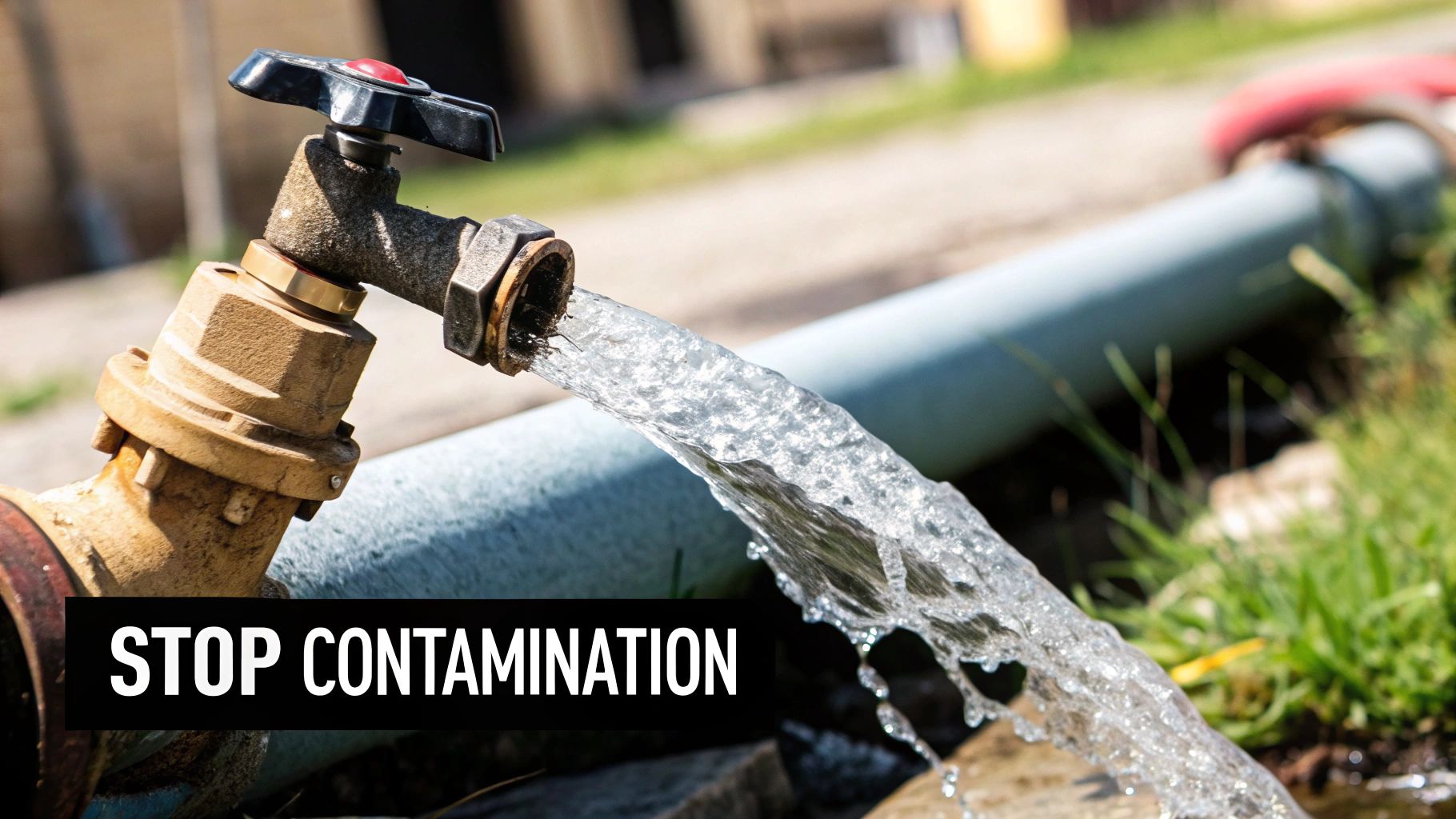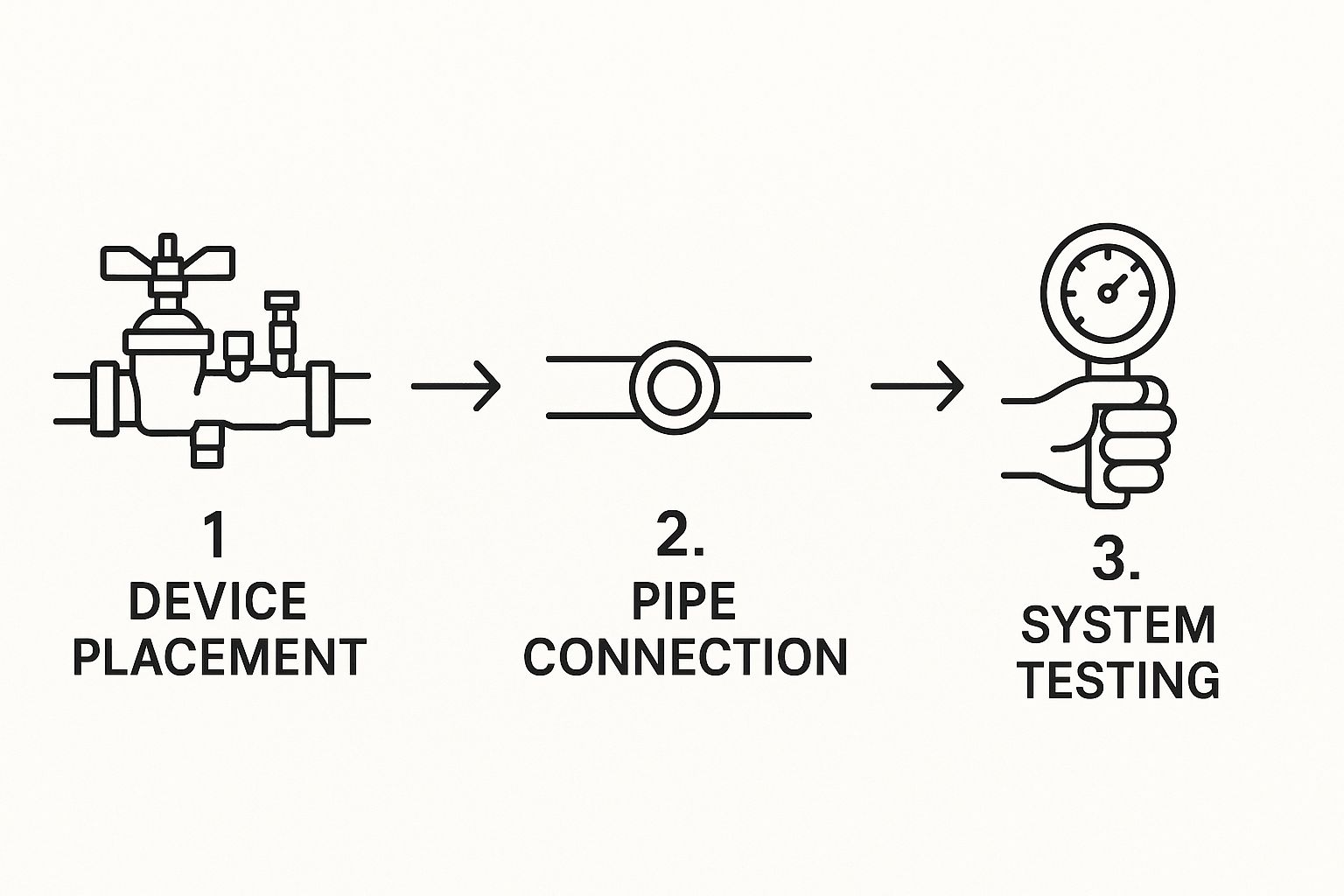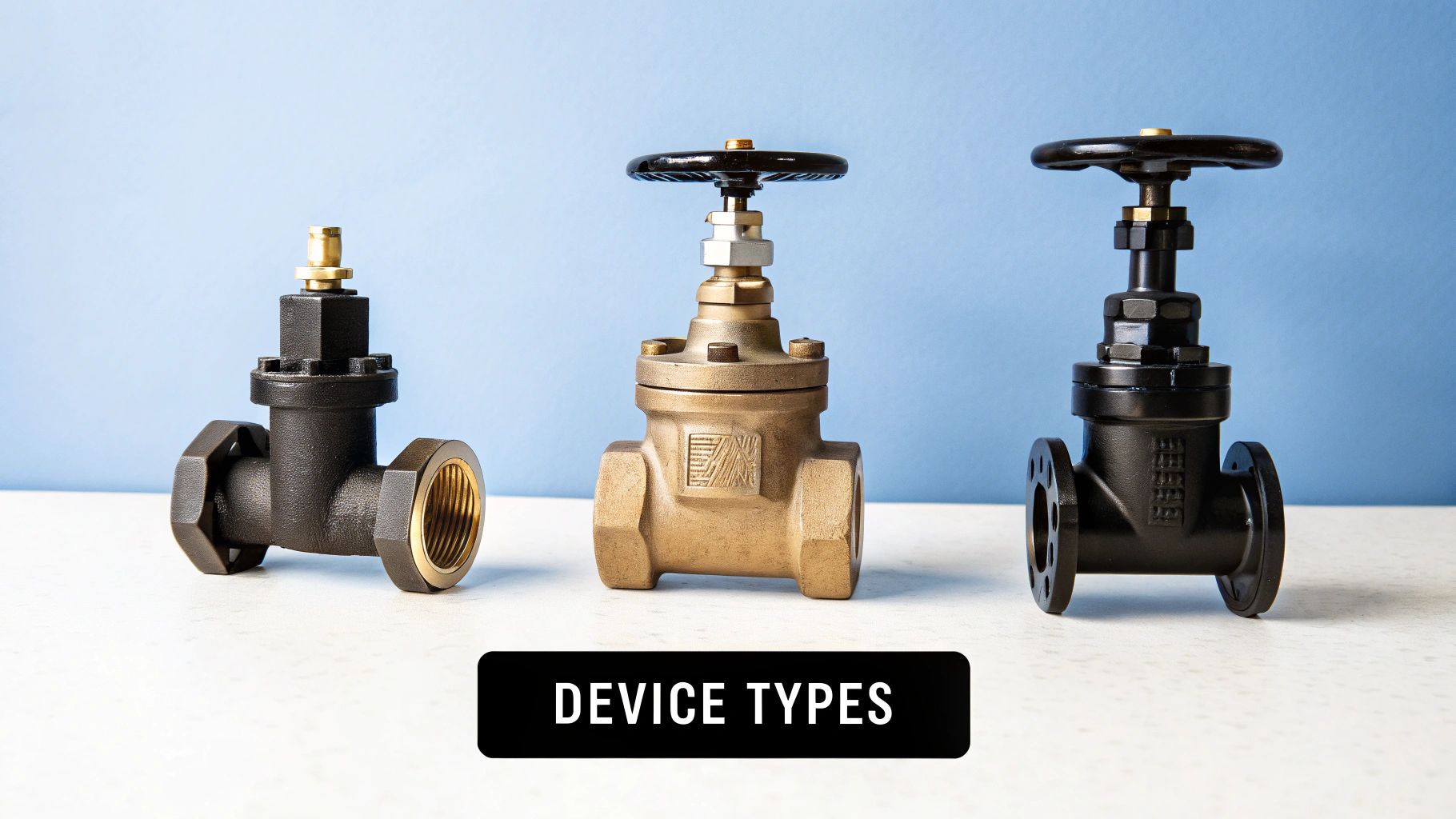UK Backflow Preventer Installation Guide
Having a backflow preventer professionally installed isn't just a simple plumbing upgrade; for many properties, it’s a legal requirement. This critical service involves fitting a specialised device into your water system to guarantee that contaminated water can never flow back into the clean public supply, which is fundamental for protecting community health.
Why Backflow Prevention Is Non-Negotiable

To really get why a backflow preventer is so essential, you first have to understand the serious risks it stops in their tracks. Our public water system depends on consistent pressure to push clean water into every building. But sometimes, things can go wrong and reverse that flow, creating a dangerous situation where used, non-potable water gets pulled back into the main supply.
This reversal can happen in a couple of key ways:
- Back-siphonage: This happens when there's a sudden pressure drop in the water main. Think of a burst pipe down the street or firefighters drawing huge amounts of water to tackle a blaze. This creates a vacuum effect, literally siphoning water back from properties connected to the line.
- Back-pressure: This occurs when a building's internal water system has a higher pressure than the mains supply. It might be caused by a faulty boiler or even a high-pressure irrigation system, which can physically push contaminated water back out into the public network.
The Real-World Consequences of Contamination
Let's paint a picture. Imagine a commercial property—say, a car wash or a hairdressing salon—that’s connected to the water mains without a proper backflow preventer. If a back-siphonage event happens, all those detergents, chemicals, and other contaminants could be sucked directly into the drinking water pipes that serve the neighbouring homes and businesses.
The results can range from unpleasant tastes and smells to a full-blown public health crisis. It’s a scenario we’ve seen happen, and the consequences are always serious.
Protecting the public water supply is a shared responsibility. A backflow incident on one property can have immediate and widespread consequences for the entire community, making professional installation a critical public health measure.
The Legal Framework in the UK
Here in the United Kingdom, protecting our drinking water isn't just good practice—it's the law. The legal backbone for this is the Water Industry Act 1991 and the Water Supply (Water Fittings) Regulations 1999. These aren't just suggestions; they are legally enforceable rules that make backflow prevention mandatory for most commercial and other high-risk properties.
Compliance is also guided by specific standards, particularly BS EN 1717, which classifies water into five fluid categories based on its risk level. Any backflow preventer installation must use a device that’s rated for the highest fluid category risk found on that property.
This strict regulatory environment is a direct response to contamination events that have happened in the past. The push for widespread adoption of these devices in high-risk settings like hospitals, farms, and food processing plants has been a true game-changer for water safety. The impact is clear: there's been an estimated 60% reduction in reported waterborne contaminant incidents linked to backflow since these rules were properly enforced. You can explore more data on the success of these efforts and their impact on public health.
Choosing the Right Backflow Preventer

When it comes to backflow preventer installation, picking the right device isn't a one-size-fits-all job. The specific preventer you need is determined entirely by the level of risk present at your property. This decision is grounded in the UK's fluid category system, a framework that classifies water based on its potential to harm the mains supply if it ever flows backwards.
Getting your head around these risk levels is the first, and most crucial, step. For instance, a simple garden tap on a residential property presents a completely different (and much lower) risk compared to the chemical mixing stations you’d find in a factory.
Matching the device to the highest potential risk on-site isn't just a recommendation; it's a legal requirement under UK water regulations. Choosing the wrong one can lead to non-compliance, but more seriously, it might not provide the protection needed, putting public health on the line.
Matching Device Types to Fluid Risk Categories
The type of backflow preventer a professional will fit is directly tied to the fluid categories laid out in BS EN 1717. These categories run from Category 1 (perfectly safe, wholesome drinking water) right up to Category 5 (water containing serious health hazards).
Here’s a breakdown of what you'll typically see:
Single Check Valves (SCV): These are the most basic form of protection. They're only suitable for low-risk situations, usually up to Fluid Category 2. A good example is a domestic appliance connection where the only change to the water is its temperature.
Double Check Valves (DCV): Offering a better safety margin, DCVs are the go-to for moderate-risk applications up to Fluid Category 3. You'll often find them protecting systems against contaminants from primary heating circuits or commercial dishwashers.
Reduced Pressure Zone (RPZ) Valves: These are the heavyweights, reserved for high-risk environments and mandatory for Fluid Category 4 applications. An RPZ valve provides the highest degree of mechanical protection and is essential for premises like hospitals, chemical plants, and morgues where contamination could have severe consequences.
For systems that deal with vacuum instead of pressure, our guide on the https://www.solenoid-valve.world/vacuum-solenoid-valve can offer more technical detail.
An RPZ valve is a clever piece of engineering. It has a relief port that will physically discharge water if it senses a backflow condition, making it a very visible and reliable safeguard against the most dangerous types of contamination.
A Quick Comparison for Your Property
To make an informed decision, it often helps to see the options laid out side-by-side. The table below breaks down the common devices, helping you understand why a professional might recommend one over another. This ensures your backflow preventer installation is compliant and safe right from the start.
Comparing Common UK Backflow Prevention Devices
| Device Type | Protection Level (Fluid Category) | Common Applications | Key Feature |
|---|---|---|---|
| Single Check Valve (SCV) | Up to Category 2 | Domestic appliance connections, hose union bib taps. | Basic, single-barrier protection. |
| Double Check Valve (DCV) | Up to Category 3 | Commercial kitchens, minor irrigation systems. | Two independent check valves for redundancy. |
| Reduced Pressure Zone (RPZ) Valve | Up to Category 4 | Hospitals, chemical plants, industrial processing. | Highest protection with a visible relief valve. |
Selecting the right backflow device requires careful thought, and the same principle applies to other key parts of a water system. For instance, a solid guide on choosing the right portable water pump can be incredibly useful for related projects where water needs to be moved effectively.
Ultimately, the best course of action is always to consult a WRAS-approved plumber. They can properly assess your property's specific risks and confirm exactly which device you need to stay compliant and safe.
What to Expect During the Installation Process
When a professional turns up to fit a backflow preventer, it’s a far cry from a simple pipe swap. It's a precise, methodical job that unfolds in clear stages, from a careful site assessment to the final checks that guarantee your water supply is protected. Knowing what’s involved helps you appreciate the skill that goes into it and what to expect on the day.
The very first job is a thorough site assessment. This isn't about finding the most convenient spot; it's about pinpointing the correct one. The engineer has to balance the manufacturer's specs with local water authority rules. A major factor here is accessibility. There must be enough clear space around the device for the annual testing, ongoing maintenance, and any future repairs.
With the perfect location sorted, the water supply to that area is shut off. This is a non-negotiable safety step to prevent any flooding and to let the plumber work on depressurised pipes. They’ll then measure and cut the pipework to accommodate the new device. This cut has to be exact – a sloppy job can lead to weak joints and leaks down the road.
Fitting the Device and Securing Connections
Once the pipe section is out, the backflow preventer can be fitted. But it’s not just a matter of slotting it into the gap. The engineer has to get the orientation right. Every backflow preventer has an arrow on its body showing the direction of flow; install it backwards, and it’s completely useless.
A common mistake we see in amateur installations is getting the orientation wrong or not leaving enough clearance. A professional job will always have the device facing the right way and will usually include unions on either side. These unions mean the device can be easily removed for a major repair or replacement without having to cut the pipes again.
After positioning the device, the plumber makes the connections. Depending on the pipe material, this might involve soldering copper or using threaded fittings with the right sealant. Every single joint must be perfectly sealed to handle constant water pressure. Even a tiny drip can lead to serious water damage over time.
This image breaks down the core stages of the physical installation.

As you can see, it’s a logical sequence, starting with strategic placement, moving to the physical connection, and finishing with essential verification.
Final Checks and System Pressurisation
Getting the backflow preventer securely in place isn't the end of the job. The final phase involves slowly turning the water supply back on to pressurise the system. This is the moment of truth.
The engineer will meticulously check the device and every new connection for the slightest sign of a leak. They'll also watch how the device behaves as the system gets back up to its normal operating pressure. For something like an RPZ valve, this means making sure its relief valve isn't dripping or discharging water. If it is, that points to an internal fault or a problem with the system's pressure.
Only when these final checks are complete, and the installation is confirmed to be leak-free and working as it should, is the job done. The engineer will then give you the necessary paperwork, which acts as your initial proof of a compliant backflow preventer installation, ready for its first official test.
Understanding Installation and Maintenance Costs

When you're looking at a professional backflow preventer installation, it's more than just a purchase; it’s a crucial investment in safety and your legal obligations. To budget effectively, you need a clear picture of all the costs involved, from the initial fitting to the long-term upkeep.
The total price isn't a simple, one-size-fits-all figure. It’s influenced by a handful of key factors that any experienced plumbing professional will need to assess on-site.
Breaking Down the Initial Installation Cost
The biggest things that will sway the upfront cost are the type and size of the preventer your property needs. For instance, a basic Double Check Valve for a low-risk commercial space is going to be far less expensive than a high-spec Reduced Pressure Zone (RPZ) valve required for a high-risk industrial facility.
But that's not the whole story. Several other elements come into play:
- Pipe Size and Material: It's simple really—larger pipes need bigger, more expensive devices and fittings. If we're working with older pipework or less common materials, the labour time can also creep up.
- Site Accessibility: Is the installation point tucked away in a cramped plant room or hidden in a high ceiling? If it's a tight squeeze or difficult to get to, you can expect the labour costs to reflect that extra effort.
- System Complexity: A straightforward job on a single incoming main is one thing. It's another beast entirely if the setup needs multiple devices or a significant rerouting of your existing pipework. For more complex systems, understanding all the components is key, and you can learn more about managing flow with our guide on pressure reducing valves for air and water.
The initial installation cost is just the beginning of the financial commitment. A common mistake I see is people forgetting to budget for the mandatory ongoing costs. These are absolutely essential for staying legally compliant and making sure the device actually works year after year.
Ongoing Costs and Long-Term Value
Once your backflow preventer is installed, it's not a 'fit and forget' device. It needs regular attention to confirm it’s still doing its job correctly. This introduces ongoing costs, mainly for annual testing and certification, which is a legal requirement for the vast majority of commercial installations across the UK.
So, what are we talking about in pounds and pence? A typical backflow preventer installation can range from £120 to £350, with the average job, including labour, sitting around £250. On top of that, you'll need to budget for the annual maintenance and certification, which usually adds an extra £100 to £150 per device.
It might seem like just another recurring expense, but this investment pays huge dividends in safety and compliance. Water suppliers have reported that proper backflow prevention is linked to a 40% decrease in cross-connection contamination incidents—a powerful testament to its real-world value. Exploring detailed cost breakdowns can give you even more insight into these figures and why they matter for water safety.
The Critical Role of Annual Testing and Certification
Getting a professional backflow preventer installation sorted is a huge step in protecting your water supply, but the job isn't finished there. It's really just the beginning. A backflow preventer is a mechanical device, full of moving parts like springs, seals, and check valves. Just like any piece of machinery, these components can wear out, get stuck, or simply fail over time. Think of it like your car's annual MOT; it needs a regular, professional check-up to make sure it's still fit for purpose and safe.
This is where annual testing and certification come into play. This isn't just some bureaucratic box-ticking exercise for the local water authority. It’s a hands-on, functional test that proves your device will actually do its job when a contamination event occurs. If you skip this crucial step, you're operating on a false sense of security, and a failed device could leave the public water supply dangerously vulnerable.
What Happens During a Test
When an accredited engineer arrives to test your backflow preventer, they'll come equipped with a specialised, calibrated test kit. The process involves isolating the device from the rest of your plumbing system and then carefully manipulating the water pressure on either side of its internal valves. In essence, they are simulating back-pressure and back-siphonage conditions in a controlled, safe environment to see if the device responds exactly as it should.
The engineer will be checking several key performance metrics:
- The check valves must hold perfectly tight against any reverse pressure.
- The relief valve on an RPZ device has to open at the precise differential pressure to discharge water.
- The entire assembly must be completely free of leaks and operate smoothly.
If the device passes every single test with flying colours, the engineer will issue a certificate of compliance. This official document is your proof that you're meeting your legal obligations and actively doing your part to protect the water supply.
The Legal and Safety Imperative
Here in the UK, skipping your annual backflow test can lead to serious legal consequences. Water authorities have the power to issue enforcement notices and, in severe cases, can even disconnect your water supply until the problem is fixed. The potential for hefty fines and legal action is very real, particularly for commercial property owners.
A failed backflow preventer is far more than a compliance issue; it’s a ticking time bomb. Every year, contamination incidents occur that could have been easily prevented by a working device, putting public health at serious risk. Regular testing is the only way to be certain your installation remains an active, reliable line of defence.
Statistically speaking, periodic testing is a cornerstone of UK water safety regulations. Recent data from bodies like the DWI shows that of the over 500,000 backflow prevention devices active in England and Wales, the rate of mandatory annual testing now tops 75% in commercial premises. This proactive approach has directly led to a dramatic fall in contamination events, with reported cases dropping from nearly 1,200 annually back in 2010 to fewer than 450 by 2022. You can explore more data on the success of these UK-wide maintenance regimes and their impact on public health.
The principles of regular checks and ensuring components function correctly are universal in any fluid control system. You can learn more about the fundamental components that prevent reverse flow in our detailed guide on check valves and how they operate.
Common Questions About Backflow Preventers
Even with a solid understanding of how they work, it's completely normal to have a few lingering questions about the practical side of owning and maintaining a backflow preventer. Let's clear up some of the most common queries we hear from customers, so you can feel confident about your responsibilities and the ongoing safety of your water system.
Can I Install a Backflow Preventer Myself?
This is a big one, and we get asked it all the time. Many people, keen to save on costs, wonder if fitting a backflow preventer is a job they can handle themselves.
The answer here in the UK is a firm and simple no. This isn't a DIY task. The work, especially for higher-risk devices like RPZ valves designed to protect against Fluid Category 4 hazards, must be carried out by a qualified and accredited professional.
That means you'll need to hire a WRAS (Water Regulations Advisory Scheme) approved plumber. There are two critical reasons for this. First, it ensures the installation is fully compliant with all current water regulations. Second, it guarantees the device is installed, tested, and certified correctly from the get-go. An improper installation isn't just a compliance issue; it could be completely ineffective, leaving the public water supply dangerously exposed.
Entrusting the job to a certified professional isn't just about ticking a box. It's your absolute assurance that the device will perform as intended during a real-world backflow event, which is the entire reason for the investment.
How Often Does My Backflow Preventer Need to Be Tested?
Another frequent question revolves around the ongoing maintenance schedule. How often do you really need to get your device checked?
For most backflow preventers in commercial or high-risk environments, the standard requirement is annual testing.
This is more than a recommendation; it's a legal mandate, particularly for devices like RPZ valves. While your local water authority sets the definitive rules for your area, you should plan for a yearly test and certification as a minimum baseline. This regular check confirms the internal seals, springs, and moving parts haven't worn out and are still capable of creating the protective barrier needed to prevent contamination. It’s a crucial part of maintaining legal compliance and protecting public health.
What Happens if My Device Fails Its Annual Test?
Finding out your backflow preventer has failed its test can be worrying, but it's important to remember that this is precisely what the inspection process is designed to catch. A failure simply highlights a potential weakness before a real contamination incident can occur.
If your device does fail, it must be repaired or replaced by a qualified professional without delay. It is illegal to knowingly leave a faulty or non-compliant backflow preventer in service. Doing so presents a direct and unacceptable risk to the public water supply.
Once the engineer has completed the repair or replacement, they will perform another test on the spot. Only after it passes will they issue a new certificate of compliance, bringing your system back into safe, legal operation.
At Solenoid Valve World, we provide a full range of WRAS-approved valves and components to ensure your fluid control systems are safe, efficient, and compliant. Find the right parts for your next project at https://solenoid-valve.world.
